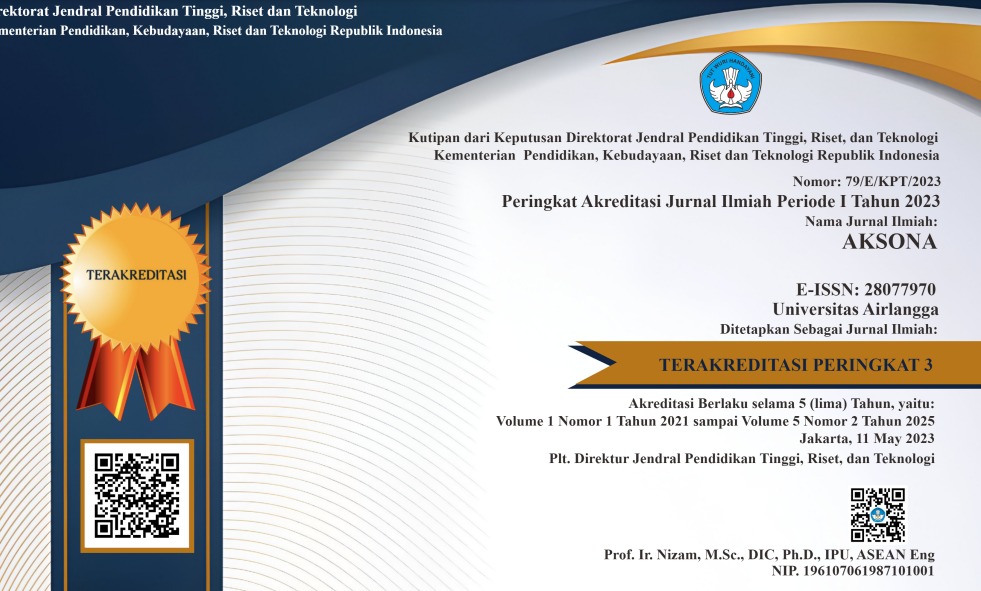Factor Associated with Orthostatic Hypotension in Parkinson’s Disease
Downloads
Highlight:
- Neurogenic orthostatic hypotension is commonly found in Parkinson’s disease (PD) and unnoticed by both patients and clinicians.
- Underweight has been associated to orthostatic hypotension in Parkinson’s disease, among other factors.
ABSTRACT
Introduction: Orthostatic hypotension (OH) affect approximately 30% of patients with Parkinson's disease (PD). This condition not only reduces quality of life but is also associated with increased mortality. OH has been shown to double the risk of falls in the elderly, worsens motor function, and accelerate cognitive decline. There has been limited study into the prevalence and contributing factors of OH in Parkinson’s disease patients in Indonesia. Objective: This study aimed to determine factors associated with OH in patients with Parkinson’s disease. The variables analyzed included age, sex, duration of PD, disease stage based on the Hoehn and Yahr scale, levodopa equivalent dose (LED), the length of antiparkinsonian agents use, MoCA Ina (Montreal Cognitive Assessment Indonesian version) score, comorbid conditions, use of antihypertensive agents, and body mass index (BMI). Methods: This is a descriptive-analytic study with a cross-sectional design. The study population consisted of all Parkinson’s disease patients who visited the neurology polyclinics at two hospitals in Palembang. Patients were selected based on specific inclusion and exclusion criteria. To discover associations, bivariate and multivariate analyses were performed. Results: The study involved 41 patients with PD at Mohammad Hoesin Hospital and Pusri Medika Hospital in Palembang, from June to December 2024. OH, was found in 43.9% of PD patients, most of whom reported symptoms. Bivariate and multivariate analyses revealed no significant associations between OH and factors such as comorbidities, the length of antiparkinsonian medication use, total LED, age, sex, duration of PD, disease stage (Hoehn and Yahr scale), and of the use of antihypertensive agents. However, underweight BMI was significantly associated with OH in PD patients (p = 0.002, OR = 34.571, 95% CI: 3.77–317.28). Conclusion:Underweight was identified as a significant associated factor for OH in PD patients.
Kelompok Studi Movement Disorders Perhimpunan Dokter Spesialis Saraf Indonesia. Buku panduan tatalaksana penyakit parkinson dan gangguan gerak lainnya. Syamsudin T, Subagya, Akbar M, editors. Perhimpunan Dokter Spesialis Saraf Indonesia; 2015. [Book]
McCann H, Cartwright H, Halliday GM. Neuropathology of α‐synuclein propagation and braak hypothesis. Mov Disord. 2016; 31(2):152–60. doi: 10.1002/mds.26421
Palma J, Gomez‐Esteban JC, Norcliffe‐Kaufmann L, Martinez J, Tijero B, Berganzo K, et al. Orthostatic hypotension in Parkinson disease: How much you fall or how low you go? Mov Disord. 2015; 30(5):639–45. doi: 10.1002/mds.26079
Velseboer DC, de Haan RJ, Wieling W, Goldstein DS, de Bie RMA. Prevalence of orthostatic hypotension in Parkinson’s disease: A systematic review and meta-analysis. Parkinsonism Relat Disord. 2011; 17(10):724–9. doi: 10.1016/j.parkreldis.2011.04.016
Bae H-J, Cheon S-M, Kim JW. Orthostatic hypotension in drug-naïve patients with Parkinson’s disease. J Mov Disord. 2011; 4(1):33–7. doi: 10.14802/jmd.11005
Braun M, Amodeo K. Orthostatic hypotension in early Parkinson’s disease: A retrospective chart review (2751). Neurology. 2021; 96(15_supplement). doi: 10.1212/WNL.96.15_supplement.2751
Umehara T, Oka H, Nakahara A, Shiraishi T, Sato T, Matsuno H, et al. Dopaminergic correlates of orthostatic hypotension in de novo Parkinson’s disease. J Parkinsons Dis. 2021; 11(2):665–73. doi: 10.3233/JPD-202239
Farrell MC, Shibao CA. Morbidity and mortality in orthostatic hypotension. Auton Neurosci. 2020; 229:102717. doi: 10.1016/j.autneu.2020.102717
Mu F, Jiao Q, Du X, Jiang H. Association of orthostatic hypotension with Parkinson’s disease: A meta-analysis. Neurol Sci. 2020;41(6):1419–26. doi: 10.1007/s10072-020-04277-w
Magkas N, Tsioufis C, Thomopoulos C, Dilaveris P, Georgiopoulos G, Sanidas E, et al. Orthostatic hypotension: From pathophysiology to clinical applications and therapeutic considerations. J Clin Hypertens. 2019; 21(5):546–54. doi: 10.1111/jch.13521
Hommel A, Faber M, Weerkamp N, van Dijk J, Bloem B, Koopmans R. Prevalence and prescribed treatments of orthostatic hypotension in institutionalized patients with Parkinson’s disease. J Park Dis. 2016; 6(4):805–10. doi: 10.3233/JPD-160853
Hiorth YH, Pedersen KF, Dalen I, Tysnes O-B, Alves G. Orthostatic hypotension in Parkinson disease. Neurology. 2019; 93(16):e1526–34. doi: 10.1212/WNL.0000000000008314
Li L, Guo P, Ding D, Lian T, Zuo L, Du F, et al. Parkinson’s disease with orthostatic hypotension: Analyses of clinical characteristics and influencing factors. Neurol Res. 2019; 41(8):734–41. doi: 10.1080/01616412.2019.1610224
Jost WH, Altmann C, Fiesel T, Becht B, Ringwald S, Hoppe T. Influence of levodopa on orthostatic hypotension in Parkinson’s disease. Neurol Neurochir Pol. 2020;54(2):200–3. doi: 10.5603/PJNNS.a2020.0019
Noack C, Schroeder C, Heusser K, Lipp A. Cardiovascular effects of levodopa in Parkinson’s disease. Parkinsonism Relat Disord. 2014; 20(8):815–8. doi: 10.1016/j.parkreldis.2014.04.007
Nakamura T, Suzuki M, Ueda M, Hirayama M, Katsuno M. Lower body mass index is associated with orthostatic hypotension in Parkinson’s disease. J Neurol Sci. 2017; 372:14–8. doi: 10.1016/j.jns.2016.11.027
Umehara T, Nakahara A, Matsuno H, Toyoda C, Oka H. Body weight and dysautonomia in early Parkinson’s disease. Acta Neurol Scand. 2017; 135(5):560–7. doi: 10.1111/ane.12633
Copyright (c) 2025 Selly Marisdina, Rini Nindela, Muhammad Hasnawi Haddani, Minda Nur'aini, Nurlia Puspita Ratnasari

This work is licensed under a Creative Commons Attribution-ShareAlike 4.0 International License.





















